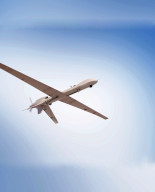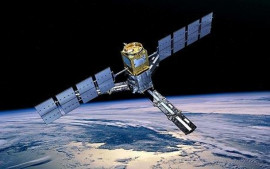

BADR-1 was a remarkable success story. A mission that was made possible by the vision and dedication of a few scientists and engineers committed to a low-cost satellite demonstration. The satellite performed as per design in all its modes of operation in orbit which had been completely simulated on site prior to the launch. This led to the tuning of the feasibility study for an earth observation satellite, which had been carried out earlier in 1986 to meet the updated needs.
The success of the very first satellite provided a tremendous boost to the confidence level of the technicians and the engineering personnel involved in the project. The satellite had been launched into an elliptical orbit and performance of the communication systems at apogee and perigee opened new avenues for future communication missions. Recently, a network named O3b has been launched into an elliptical orbit to provide broadband Internet connectivity through a constellation of eight satellites, four of which have already been launched.
BADR-1 was a free-flying mass of about 52 kilogrammes and was adequately equipped to meet telemetry and telecommand needs. Satisfactory performance had enabled the team to prepare for a follow-on satellite with more demanding goals. The follow-on satellite, known as BADR-B, was to carry a charged-coupled device (CCD) camera on-board for Earth imaging. This required a highly stable platform and earth pointing mechanism. Fortunately, the success of the first satellite had earned sufficiently reasonable reputation to attract the attention of the European Space Agency and the UK Space Agency’s Rutherford Appleton Laboratories to contribute to radiation dosimetery and depth of discharge experiments and CCD camera payload. This was a tremendous boost as no university or institute in the country was in a position to take part. This was an important step seeking international cooperation. Acquiring launch from the Russian Space Agency was also the first such initiative to materialise.
On the national level, prototyping of the honeycomb structure was carried out in cooperation with the Pakistan Council of Scientific and Industrial Research laboratories, while PCBs were prepared by the National Institute of Electronics, and the National Silicon Institute was encouraged to do some solar cell testing. A software house from Karachi was contracted to develop the ground control and tracking system software. A comprehensive tracking, telemetry and telecommand station was set up in Lahore with the facility to acquire imaging data and tracking satellites in low earth orbits.
BADR-1 had been conceived in the wake of Pakistan’s communication satellite system, PAKSAT, and its main purpose was to train adequate manpower and develop necessary infrastructure to undertake the satellite project for domestic communication needs of the country. When the government showed its inability to support the PAKSAT project, a 10-year plan for in-house development of an earth observation satellite, an all weather remote sensing satellite and a low capacity communication satellite was presented. This plan was in line with the original objectives of human resources development, infrastructure augmentation, industrialisation and involvement of the academia in research and development. It is clearly understood that no progress could be made without taking control of your resources and making your own decisions. You can’t expect to make progress on borrowed technologies and products. Proper utilisation of trained manpower is therefore key to progress, integrity and national security.
We are fortunate that after more than 50 years, space holds the same fascination today and continues to do so in a more and more enchanting manner. Small satellites have become Cubesats, Nanosats and soon Picosats to catch the imagination of even schoolchildren. It is about time that Pakistani students at the college level, at least, were involved in such projects. On the other hand, small satellite systems are actively pursued for diverse concepts such as providing low-cost remote sensing data products at unprecedented revisit rates, and manifesting novel sensors as hosted payloads for national security and natural disaster mitigation.
Published in The Express Tribune, July 22nd, 2014.
Like Opinion & Editorial on Facebook, follow @ETOpEd on Twitter to receive all updates on all our daily pieces.
COMMENTS (29)
Comments are moderated and generally will be posted if they are on-topic and not abusive.
For more information, please see our Comments FAQ












































@Author.: You are correct about using satellites in elliptical orbits for communicating TV programs. However, these satellites can provide TV programs only during the time their 'footprint' falls on the target region. In other words, these satellites cannot provide TV programs 24X7.
I am sure you know that we always try to have a geostationary satellite for TV programs so that we can have programs telecast 24x7. Another option is to beam off from multiple non-geostationary satellites. I do agree though that it is not MANDATORY to have a geostationary satellite for telecasting TV programs.
@Jaffer Sheriff:
Reading is a very good habit, and it should be part of education. Just to try and find faults only can sometimes lead to embarrassment. Elliptical orbits have been used and are now planned to increase their uses for communication.
@Chachoo: I could not agree with you more. Excessive delays in the launch of BADR-1 and BADR-2 satellites was due to non availability of satellite launch opportunity. There is a need to develop a low cost launch vehicle to facilitate CUBESATS and yet smaller versions available and built by the universities. There is a good market for these launch vehicles.
@Chachoo: @AVM Polpot: @Jaffer Sheriff: You must have heard about the Molnaya orbit the Russians used for providing communication including TV to their people in the Siberia. This was / is from elliptical orbits. Now we have better technology to provide better and more coverage.
Shamefully we are very far behind other nations in space exploration. We need to invest more in SUPARCO (our national space agency) and our space program. We need to develop our own Space Launch Vehicles (SLVs), send an astronaut into space, land on a rover and a man on the moon and then eventually mars!
@Expat Pakistani: I certainly hope so, and pray for that day. We are one people, and it is ridiculous that we bicker like little children - when we should be active like grownups and collaborating.
Would it not be wonderful if we, together, surpass UK by 2047 in every field? We can do that, if we stop wasting our energy in these pointless loser (and well past sell-by-date) augments like Kashmir, and focus on how we can conquer space together.
Why focus on Kashmir, when Jupiter beckons!
@sharabi: @Karachiite.A: Read complete article. "have been stuck at the Prime Minister's Office (PMO) for months now."
According to the official, Pakistan on the other hand moved swiftly to put "all documents in place" and "is all set to become an associate member before India".
To be an associate member, India will have to pay $10.7 million annually. The status of associate member is also the pre-stage to full membership. As an associate member, India would have been entitled to attend open and restricted sessions of the organization.
Rolf Dieter Heuer, Director-General of Cern had recently said that Cern had become highly popular in India. Cern receives the highest number of applications for summer internships from India. Cern discovered the Higgs Boson popularly known as the god particle.
The associate membership will open the doors of mega science experiments for Indian scientists and will also allow Indian industry to participate in bids for Cern contracts across various sectors. India was given "Observer" status in Cern in 2002."
well this article was about Pakistan, so is it a necessity to bring INDIA? India belongs to different group.
@sundeep: thank you for your kind words. Indians and Pakistan collaborate and work well together abroad. Hopefully, they can collaborate in this field at home as we'll.
@Karachiite.A: Strange that you are dragging China when comparing with India instead of Pakistan???
When did Pakistan become a Chinese state?? or has China started issuing free visa for Pakistan????
This is like a pauper teasing a man that his house isnt bigger than his neighbor's house..just because you praise my neighbor doesnt mean he will give asylum to you,maybe he might throw a bone at times
@Oats: Some guys just never learn or grow up.
Sad
@sudeep: The level of mischief by Indian trolls never ceases to amaze me. You should focus on Indian terrorism in Kashmir over the last 60 years and why there is tension in the region. Once the Kashmir issue is settled according to UN resolutions, there should be no need for any disputes in South Asia between India and Paksitan.
@Talking Point: This neutrino lab testing facility is delayed and facing resistance from the locals. Hope its gets completed. China has completed One and building a bigger and better neutrino obsv. Nobody works like Chinese as one Nation.
http://www.thehindu.com/opinion/lead/a-controversy-we-can-do-without/article3975090.ece
I don't know why people are having problem with author claiming Pakistan being first Muslim country.
Author Sir, one doubt - Is this about Pakistan or some other country. Do you know the meaning of apogee and perigee. Communication satellites are placed in Geo-synchronous orbits and not elliptical orbits. The rocket carrying a satellite to be launched towards eastern direction so as to enrich its velocity by earths rotation towards east. How Pakistan launch rockets from its soil while having countries on the eastern side. It has to do it from some other country. Pakistan space programme was discontinued as Saudi Arabia and US did not give charity money.
What have been the tangible and real benefits to the population from your space program ? What further progress has the space agency made after this launch?
The root of your problem lies in the first 5 words of the article. Russia does not claim to be the first 'atheist' country in space nor is America's claim that it is the first 'Christian' country in space.
Look at issues without the lens of religion.
@Karachiite.A: Pak is only an associate member and not a permanent one . Satellites before launch vehicles , permanent membership before associate membership - way to go Pak. Meantime India would be completing its own 1.3 km neutrino observatory by 2015 in the southern dictrict of Theni in Tamil Nadu.
what does it have to do with being a muslim country. I really don't understand. Say nth country in the world or something else. I may be nitpicking on an irrelevant point but really don't understand this obsession with religion and need to compare to other islamic countries in areas of scientific achievement.
Anyways, good to see such an article. good luck!
How could you forget Rehbar rocket project of Pakistan that was one of the first project of its kind in this region of South Asia. http://en.wikipedia.org/wiki/Rehbar-I
Also you failed to mention the development of SLV ( Space Launch Vehicle ) that is as vital as the satellite itself to launch rockets into space. Pakistan must develop its Own SLV as soon as possible and without SLVs we are not going anywhere.
@Feroz: @Spock: @AVM Polpot: Pakistan has taken the lead at CERN, now a permanent member, beating India. Badr 1 was an indigenous satellite weighing about 52 kg, all developed by Pakistan, at that point in time China and Pakistan has no collaboration in satellite design and development. Indians will never believe in any scientific achievement of the country, and even if they believe it, won't accept it. This is a foregone conclusion.
Here is a link by TOI.
http://timesofindia.indiatimes.com/world/pakistan/Pak-to-beat-India-to-associate-membership-to-Cern/articleshow/31075765.cms
http://en.wikipedia.org/wiki/Badr-1
"" Looking back at Pakistan’s space history" ++++++++++++++++++++++++++ So how many satellites has Pakistan lofted into space in last 60 Years? And Looking forward at Pakistan’s space future how many are planned in the next 60 years?
Author makes all the failures and negligible successes as huge achievements. Pakistan has never developed a satellite of any commercial worth or has launched a satellite on its own. After 50 years of money wasting SUPARCO has nothing to show. All the nano satellites author is talking about were purchased from abroad and launched by someone else.
Even Red Bull has a better space programme.
The positive spin offs from development of Space technologies, can enhance the scientific temper prevalent in the country, with multiple benefits. A suitable budget has to be allocated for this activity, so scientists do not have to go running everyday to the government and can focus on their work.
Good Article. This is what Pakistan needs to demonstrate to itself and the world by showcasing its technological achievements. Just do not bring religion into it, by saying it is the first Muslim country to launch etc.
Space program was much earlier in place which the writer failed to mention, way back in 1962. Satellite Launch(Badr 1) was done years later.
Rehbar was series of sounding rocket launches into the upper atmosphere and the edge of space. Rehbar-I was the first rocket launched by the Space and Upper Atmosphere Research Commission (SUPARCO), on 7 June 1962.[1] Rehbar-I was a two-staged Solid fuel rocket.
http://en.wikipedia.org/wiki/Rehbar-I
We are fortunate that after more than 50 years, space holds the same fascination today and continues to do so in a more and more enchanting manner.
Can't agree more, with everyone still quarreling on who sights the new moon every Id!
Best of luck on this exciting journey.
I really wish Pakistan spend its time, energy and passion on these ambitious endeavors, enhancing mankind's knowledge and reach, instead of wasting the same on sending terrorists all over the world. You guys can really gain respect if you focus on good activities